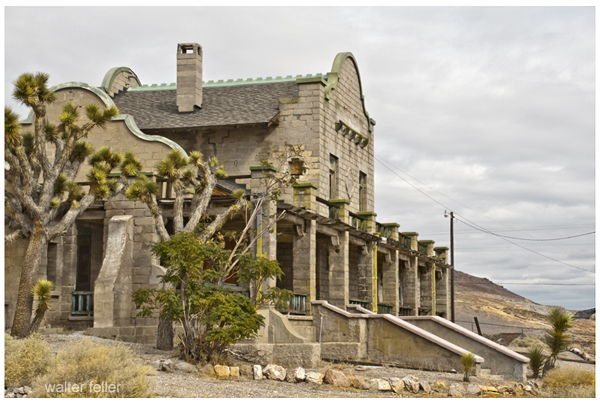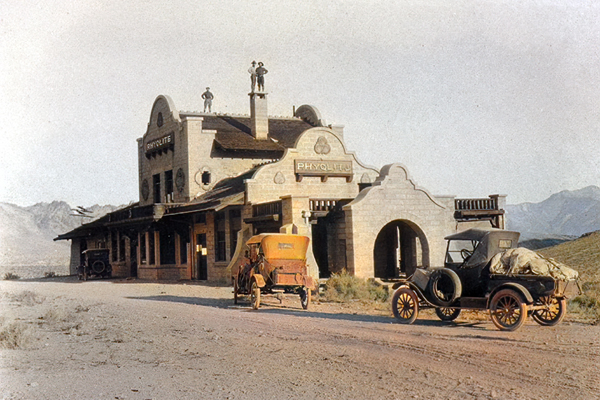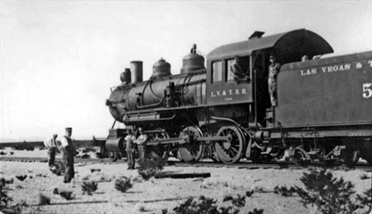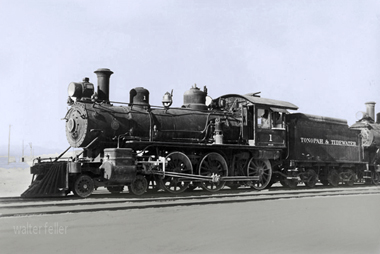Rhyolite Train Depot

2011
In keeping with its prominence as a mining center, Rhyolite was serviced by three railroads: the Las Vegas & Tonopah, the Tonopah & Tidewater, and the Bullfrog-Goldfield.
The Las Vegas & Tonopah Railroad laid one mile of track per day, then two miles of track per day, in its hurry to connect Rhyolite with the outside world. The first train from the Las Vegas & Tonopah entered Rhyolite at 7 p.m. on December 14, 1906, with about 100 passengers.
It was a big deal for a young mining town to be serviced by one railroad, but three railroads were almost unheard of in the history of Nevada. With three railroads, it seemed that Rhyolite was destined to be the largest mining camp in the state and the first few boom years made this prediction look inevitable.
By 1907, the Las Vegas & Tonopah alone was hauling 50 freight cars into town per day. The large volume of freight required a large depot to handle it.
In September 1907, the Las Vegas & Tonopah began building the depot that stands before you. It is constructed of concrete block with a solid concrete foundation in the Mission Revival style. There was a gentlemen's waiting area on the east end and a ladies' waiting room on the west end. A separate baggage room was located east of the men's waiting area. The ticket office was located in the center of the building, and the ticket agent's quarters were located upstairs.
It was planned to take an entire city block on Golden Street and cost approximately $130,000 - the equivalent of $3,798,393 in 2021.
The Las Vegas & Tonopah Railroad Depot was completed in June 1908, around the same time that Rhyolite began its slow decline. Within months of its completion, more people were leaving Rhyolite through the depot than were arriving.
The railroad turned a small profit in 1908 but lost money every following year until it was finally dismantled in 1919. The tracks were salvaged, but the depot was left to stand as one of the few remaining buildings from the Rhyolite boom, primarily because it could not be moved elsewhere.
In the 1920s, Rhyolite enjoyed a small revival through tourism. Wes Moreland bought the depot in 1935 and, beginning in 1937, operated it as the Rhyolite Ghost Casino. The drinking and gaming were conducted downstairs, while a different type of hospitality, reportedly staffed by "working women," was conducted upstairs in the old ticket agent's quarters.
Like the town before it, the casino had a relatively short life. The onset of World War II, and the associated war effort, including fuel rationing, completely drained the area's economy.
By the 1960s, the building had passed to Moreland's sister, Mrs. Herschel Heisler, who operated the lower floor as a museum and gift shop for tourists.
The railroad turned a small profit in 1908 but lost money every following year until it was finally dismantled in 1919. The tracks were salvaged, but the depot was left to stand as one of the few remaining buildings from the Rhyolite boom, primarily because it could not be moved elsewhere.

Rhyolite tourists
In the 1920s, Rhyolite enjoyed a small revival through tourism. Wes Moreland bought the depot in 1935 and, beginning in 1937, operated it as the Rhyolite Ghost Casino. The drinking and gaming were conducted downstairs, while a different type of hospitality, reportedly staffed by "working women," was conducted upstairs in the old ticket agent's quarters.
Like the town before it, the casino had a relatively short life. The onset of World War II, and the associated war effort, including fuel rationing, completely drained the area's economy.
By the 1960s, the building had passed to Moreland's sister, Mrs. Herschel Heisler, who operated the lower floor as a museum and gift shop for tourists.
Since the 1930s, the depot has passed from person to person, eventually ending up with the Barrick Mining Company.
At the time the depot was built, the local newspaper claimed it was "the finest in the state." Today, it is one of the best-preserved examples of early twentieth-century Mission Revival train depots in Nevada.
from; BLM sign on site

Las Vegas & Tonopah

Tonopah & Tidewater
